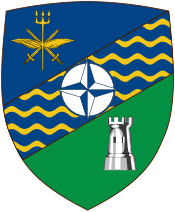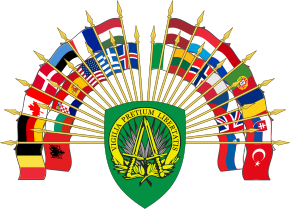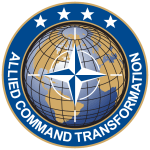Allied Maritime Command
Allied Maritime Command (MARCOM) is the central command of all NATO maritime forces and the Commander MARCOM is the prime maritime advisor to the Alliance. When directed by the Supreme Allied Commander Europe (SACEUR), it provides the core of the headquarters responsible for the conduct of maritime operations. The command is based at the Northwood Headquarters in northwest London.
| Allied Maritime Command | |
|---|---|
 Coat of arms | |
| Active | CINCEASTLANT: 1952–2004 CC MAR, Northwood: 2004–2010 Allied Maritime Command, Northwood: 2010–2012 MARCOM: 2012–present |
| Allegiance | |
| Location | Northwood, United Kingdom |
| Commanders | |
| Commander | Vice Admiral Keith Blount, RN |
| Deputy Commander | Vice Admiral Didier Piaton, French Navy |
History
The Commander-in-Chief, Home Fleet (Royal Navy), gained a NATO responsibility as Commander-in-Chief Eastern Atlantic Area (CINCEASTLANT), as part of SACLANT, when the NATO military command structure was established in 1953. CINCEASTLANT headquarters was established at the Northwood Headquarters in northwest London.[1]
Commander-in-Chief Eastern Atlantic was redesignated as Commander, Allied Maritime Component Command Northwood ('CC-Mar' or AMCCN) around 2004.[2] The command, which was renamed Allied Maritime Command Northwood in 2010, reports to Allied Joint Force Command Brunssum.[3]
At the 2010 NATO Summit in Lisbon it was decided to create a leaner and more effective command structure.[4] This reduced the number of major headquarters from 11 to 7 and, in particular, led to the deactivation of the Allied Maritime Command Naples on 27 March 2013 leaving the newly named MARCOM as the sole maritime component in NATO.[5]
MARCOM led Operation Active Endeavour, NATO's only Article-5 operation which ended in 2016. MARCOM also led Operation Ocean Shield, NATO's counter-piracy operation in the Gulf of Aden and Indian Ocean which also ended in 2016.[6]
Currently, MARCOM leads Operation Sea Guardian designed as a Maritime Security Operation to provide security in the Mediterranean Sea.[7][8]
Role
MARCOM was created through the North Atlantic Council to ensure the interoperability of NATO maritime forces, and placed directly under the Supreme Allied Commander Europe to be the leading voice on maritime issues within the Alliance. It is responsible for planning and conducting all NATO maritime operations.[9]
Current Structure
The NATO Military Command Structure consists of two strategic commands directed by the North Atlantic Council:[10]
- Liaison: Provides advice and support to the NAC
| Political strategic level: | |||||||||||||||||||
| NATO SG (NAC) Brussels, BE | IS Brussels, BE | ||||||||||||||||||
| Military strategic level: | |||||||||||||||||||
CMC (NATO MC) | |||||||||||||||||||
 SACEUR (ACO, SHAPE) Mons, BE |  SACT (ACT, HQ SACT) Norfolk, US | ||||||||||||||||||
| Operational level: | |||||||||||||||||||
Standing Maritime Groups
MARCOM leads four standing NATO maritime groups, two frigate groups and two mine countermeasures groups. The Standing NATO Maritime Groups are a multinational, integrated maritime force made up of vessels from allied countries. The ships and any aircraft aboard are available to NATO to support Alliance tasking. These groups provide NATO with a continuous maritime capability. The command is also responsible for additional naval assets as they support NATO missions.[11]
Current groups are:
- Standing NATO Maritime Group 1 (SNMG1)
- Standing NATO Maritime Group 2 (SNMG2)
- Standing NATO Mine Countermeasures Group 1 (SNMCMG1)
- Standing NATO Mine Countermeasures Group 2 (SNMCMG2).
References
- "The Military Structure". NATO. Retrieved 7 April 2019.
- "The Permanent Joint Headquarters". UK Government. Retrieved 15 June 2014.
- "The Evolution of NATO's Command Structure, 1951–2009" (PDF). NATO. Retrieved 16 April 2013.
- "NATO Lisbon Summit 2010". NATO. Retrieved 27 February 2014.
- "Deactivation ceremony of Allied Maritime Command Naples". Headquarters Allied Joint Force Command Naples. Archived from the original on 14 July 2014. Retrieved 16 April 2013.
- "2009 Operation Ocean Shield News Articles". Manw.nato.int. Archived from the original on 29 April 2011. Retrieved 19 May 2011.
- "Operation Sea Guardian". NATO. 11 December 2017. Retrieved 22 February 2018.
- "2017 - OPERATIONS / SEA GUARDIAN". NATO. 11 December 2017. Retrieved 22 February 2018.
- "MARCOM – Mission". NATO. Retrieved 27 February 2014.
- "Command Structure" (PDF). NATO. Retrieved 19 October 2019. and "Military Command Structure". shape.nato.int. Supreme Head Allied Powers Europe. 12 February 2020. Retrieved 12 February 2020.
- "Allied Maritime Command - Standing Forces". NATO. Retrieved 8 May 2016.
